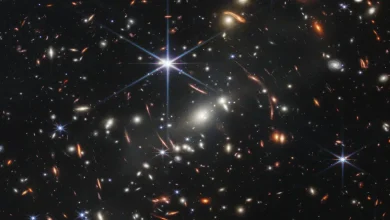In the early days of feature-length computer animation, there was an unofficial list of objects and textures that were notoriously difficult to master, with hair, water, and human faces chief among them. Netflix’s new animated feature The Sea Beast shows how far the medium has come over the last few decades — but it simultaneously shows how uninspired big-budget animation can still look, sometimes moments after it delivers a visual wow.
Specifically, this ocean-set adventure story deploys mega-gallons of computer-animated water with great skill. On the surface, as hunter ships prowl the sea for fearsome beasts that supposedly threaten humanity, the water shimmers and churns. Underneath, when sailors are occasionally dragged down to face enormous, kaiju-esque creatures, the murk creates a spare, ethereal beauty. The creatures themselves are a wonder of economical design: cartoony enough for readable expressions, imposing enough to put a good, momentary scare into smaller audience members.
So why is every human in this overpopulated story so dull to look at? The most distinctive by default is Maisie Brumble (Zaris-Angel Hator), a young orphan who reads of heroic beast-hunters and dreams of joining them on the high seas. She’s a Black girl, which ensures that she doesn’t look exactly like every other plucky young animated hero. But in general, the Sea Beast approach to human designs is to imitate recent Disney features like Moana or Encanto and make their eyes a bit smaller. Jacob Holland (Karl Urban), the strapping sailor who becomes Maisie’s reluctant guardian when she stows away on his monster-hunting ship, isn’t a caricature of swashbuckling masculinity or a clever visual variation on a familiar theme. He’s just a generic-brand version of a Disney hero.
:no_upscale()/cdn.vox-cdn.com/uploads/chorus_asset/file/23706665/The_Sea_Beast_00_32_07_18.jpg)
It’s understandable that a Disney influence would inform so much of The Sea Beast. Its director, Chris Williams, is a two-decade veteran of Walt Disney Animation Studios, where he was on directing teams responsible for Bolt, Big Hero 6, and Moana. He also worked as part of Disney’s story trust on many other projects. There’s a bit of Moana in this story of an expert sailor mentoring and learning from a curly-haired youngster, as well as a dash of Pirates of the Caribbean, where rougher-hewn sailors are challenged by soldiers of the crown who want to take over the job of monster hunting.
Outside the Disney sphere (though not worlds away), there are strong overtones of How to Train Your Dragon, where a pre-industrial society lived in fear of fantastical creatures. When Jacob and Maisie are separated from their crew, they come face to face with a massive horned beast (possibly amphibian, given its dexterity both in water and on land), who Maisie nicknames Red, after its bright skin color. Though the creature isn’t as puppyish as Dragon’s Toothless, its response to the protagonists challenges some assumptions about these sea creatures, stemming from old-timey maps and Maisie’s supposedly true-life storybooks.
None of this is bad material for a children’s animated feature, and The Sea Beast offers several breaks from tedious recent trends in animation. The dialogue is written and performed in a vernacular that reaches for a kind of offhand, English-accented poetry — the sea beasts, for example, are described as “nature’s darkest design.” Though the language doesn’t always hit the mark, it’s almost completely free of tinny sarcasm and faux-comic placeholders. (“Awkward!” “Well, that happened,” and the like.) Similarly, the grandeur of the movie’s strongest visuals is allowed to stand on its own, favoring painterly compositions of the ocean’s frightening vastness over busy, desperate-to-please antics.
:no_upscale()/cdn.vox-cdn.com/uploads/chorus_asset/file/23612491/The_Sea_Beast_00_07_53_05.jpg)
But maybe Williams and his crew could have been a little more eager to please. At times, The Sea Beast moves at a sluggish pace. After Maisie is introduced in her first brief scene, for example, she disappears from the movie for a stretch, slowing the film’s momentum. (My 6-year-old: “It seems like the hunters are the main characters, not the girl.”) Later on, the movie decelerates again for some speechifying, and in general greatly overestimates audience interest in Captain Crow (Jared Harris), a vaguely Ahab-like figure obsessed with getting revenge on the giant creature that has so long eluded him.
Captain Crow is an issue for the film: He isn’t interesting to look at, he isn’t much fun to be around, and he’s too human to function as a genuinely deranged villain. The movie’s nearly two-hour run time illustrates the pervasiveness of Netflix bloat more than the complexity of its themes, which are pretty familiar, in spite of the elevated language.
It’s difficult to tell whether Netflix’s feature animation will eventually develop its own identity. For now, there’s one more comparison that applies to The Sea Beast: With its lush animation of mostly dull characters, it recalls the early 2D films from DreamWorks, before Shrek hastened its pivot away from hand-drawn cartoons. Like The Prince of Egypt or Sinbad: Legend of the Seven Seas before it, The Sea Beast ditches talking animals and funny sidekicks, but it can’t fully shake off its Disney influences. It’s a whole lot of well-animated beasts and water, with nowhere to flow.




